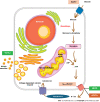Management of monogenic diabetes in pregnancy: A narrative review
- PMID: 38313847
- PMCID: PMC10835499
- DOI: 10.4239/wjd.v15.i1.15
Management of monogenic diabetes in pregnancy: A narrative review
Abstract
Pregnancy in women with monogenic diabetes is potentially complex, with significant implications for both maternal and fetal health. Among these, maturity-onset diabetes of the young (MODY) stands out as a prevalent monogenic diabetes subtype frequently encountered in clinical practice. Each subtype of MODY requires a distinct approach tailored to the pregnancy, diverging from management strategies in non-pregnant individuals. Glucokinase MODY (GCK-MODY) typically does not require treatment outside of pregnancy, but special considerations arise when a woman with GCK-MODY becomes pregnant. The glycemic targets in GCK-MODY pregnancies are not exclusively dictated by the maternal/paternal MODY genotype but are also influenced by the genotype of the developing fetus. During pregnancy, the choice between sulfonylurea or insulin for treating hepatocyte nuclear factor 1-alpha (HNF1A)-MODY and HNF4A-MODY depends on the mother's specific circumstances and the available expertise. Management of other rarer MODY subtypes is individualized, with decisions made on a case-by-case basis. Therefore, a collaborative approach involving expert diabetes and obstetric teams is crucial for the comprehensive management of MODY pregnancies.
Keywords: Diabetes; Glucokinase; Hepatocyte nuclear factor 1-alpha, hepatocyte nuclear factor 1-beta, and hepatocyte nuclear factor 4-alpha; Insulin; Maturity-onset diabetes of the young; Pregnancy; Sulphonylurea.
©The Author(s) 2024. Published by Baishideng Publishing Group Inc. All rights reserved.
Conflict of interest statement
Conflict-of-interest statement: All the authors report no relevant conflicts of interest for this article.
Figures


References
-
- Bonnefond A, Unnikrishnan R, Doria A, Vaxillaire M, Kulkarni RN, Mohan V, Trischitta V, Froguel P. Monogenic diabetes. Nat Rev Dis Primers. 2023;9:12. - PubMed
-
- Bishay RH, Greenfield JR. A review of maturity onset diabetes of the young (MODY) and challenges in the management of glucokinase-MODY. Med J Aust. 2016;205:480–485. - PubMed
-
- Chakera AJ, Spyer G, Vincent N, Ellard S, Hattersley AT, Dunne FP. The 0.1% of the population with glucokinase monogenic diabetes can be recognized by clinical characteristics in pregnancy: the Atlantic Diabetes in Pregnancy cohort. Diabetes Care. 2014;37:1230–1236. - PubMed
-
- Naylor R, Knight Johnson A, del Gaudio D. Maturity-Onset Diabetes of the Young Overview. 2018 May 24. In: GeneReviews® [Internet]. Seattle (WA): University of Washington, Seattle; 1993. - PubMed
Publication types
LinkOut - more resources
Full Text Sources
Miscellaneous

